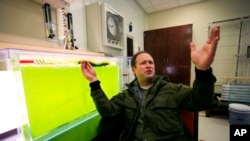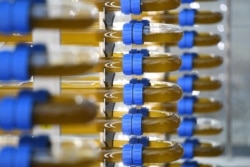Algae often gets a bad rap — for creating dead zones in the ocean and toxic pond scum when the "wrong" algae blooms. But it also has a talent that may help people around the world.
The tiny single-celled, plantlike organisms known as algae are more efficient than other organisms at converting sunlight and carbon dioxide into the raw materials needed for foods, products and fuels. And not just a few specialized fuels.
At the National Renewable Energy Laboratory (NREL) in Golden, Colorado, scientist Lieve Laurens said algae biofuels can do almost everything that’s done by fossil fuels, including powering anything from trucks to cargo ships.
"People have flown airplanes on mixtures of algae fuels," Laurens said.
Algae’s potential to provide a homegrown, renewable source of fuels is one reason the U.S. Department of Energy's Bioenergy Technologies Office funds NREL’s algae research.
The Intergovernmental Panel on Climate Change (IPCC) warns that rising carbon dioxide levels accelerate global climate change and ocean acidification. Fossil fuels are a major source of carbon dioxide, because as they burn, they release carbon that otherwise would have stayed sequestered in the ground.
The IPCC urges countries around the world to stop adding carbon to the atmosphere, and instead, to actually pull carbon dioxide from the air.
While the U.S. has not signed on to the IPCC goals, it has recently enacted Carbon Capture Tax Credits (45Q) for businesses that reduce their carbon footprint, compared with what it would have been if they had used petroleum products.
Also, the U.S. farm bill now recognizes algae as a crop, giving algae farmers access to crop insurance. These legislative changes give algae farmers more opportunity to profit and algae farms to grow into a major source of carbon capture.
(Carbon capture is a process in which carbon dioxide is trapped as it is emitted from a source. It is then transported and stored usually deep underground.)
As algae fuel burns, it releases carbon. But algae grows by pulling carbon from the atmosphere. It’s a carbon-neutral biofuel that is so efficient at converting sunlight and carbon dioxide into fuels and products, the Department of Energy estimates algae could produce 60 times more energy per hectare than traditional land-based biofuel plants, such as corn, soy or sugar cane.
Algae crops offer additional benefits. They can grow without competing for the water and farmland needed by other crops.
Laurens said many microalgae flourish in seawater, brackish water, reclaimed water, and water produced during oil and gas operations. Even good soil is not required because farmers generally grow algae in long, shallow rows of water called “raceway ponds” lined with plastic, meaning algae is "grown on top of the soil," she said.
But whether this means a smaller carbon footprint depends on some other factors. If algae farmers rely on petroleum-based fertilizers, ammonia especially, and petroleum-based processing methods, NREL’s analysis indicates algae production might release more carbon than it saves.
Fortunately, algae can thrive on fertilizers extracted from feedlots, sewage treatment plants and agricultural runoff. Algae grows better when it receives extra carbon dioxide from sources such as power plant exhaust. Feeding algae these pollutants can clean up pollution and increase carbon capture. The new government incentives make this more possible.
Algae has potential to feed and fuel the world, but unlike rice and wheat, it’s not a crop with thousands of years of cultivation under the trial and error. Algae scientists are working to catch up fast, starting with just which algae to grow.
Like any crop, microalgae must resist pests, offer predictable growth and provide profitable harvests. From the thousands of algae strains so far collected from nature, NREL has helped identify more than 300 suited to cultivation.
NREL scientists test these in laboratory flasks filled with water that’s a brilliant green, thanks to growing algae. Researchers meticulously monitor the nutrients they give each algae strain and even the time of day they harvest it. They track the most efficient ways to process the algae, then they inject it into lab instruments that include mass spectrometers that measure how much protein, oil and sugar that strain provides.
NREL shares this data with researchers around the world. It also shares data about how to plan a profitable algae farm.
Laurens said small-scale algae “farms” can grow even in the cold and dark, if they are in climate-controlled bioreactors. These bioreactors are basically tubes of water and algae, which are “fed” with artificial light. Bioreactors can be installed near waste treatment plants to clear out excess nitrogen runoff. They can do the same for soy and corn fields. They also can eat up carbon dioxide exhaust from power plants and cement factories, scientists say.
Laurens said that algae farms are even more profitable when they’re grown in outdoor ponds where it’s warm and sunny. Dozens of U.S. farmers now grow shallow ponds of algae in New Mexico, California, Texas, Florida and Hawaii — even in deserts. The farms NREL works with are typically less than 100 hectares in size.
Laurens said farms will be the most cost-effective as they grow to 200 or 400 hectares or larger — large enough to install a biorefinery for making a wide range of algae products.
NREL analysis indicates producing algae fuel today would cost five to 10 times more than fossil fuel. So it isn’t happening.
Fortunately, however, algae can be used in many products other than fuel, including Omega 3 nutritional supplements, energy bars, laundry detergent, food for fish farms and livestock, pet food, as well as foam for running shoes and car seats. These products often have higher profit margins than that of algae fuel, and they provide additional benefits.
Algae-based Omega 3 supplements and livestock meal may reduce the overfishing of anchovies and krill. Algae-based plastics may prove more biodegradable than petroleum-based plastic.
And, as more businesses earn profits from algae products at a larger scale, they have more ability to also make algae fuel.
Electric cars are starting to replace gas and diesel cars, so in the years ahead, the need for fossil fuels may drop. But liquid fuels will stay in demand for trains, planes and ships.
Within the next 10 years, Laurens predicted algae fuel may cost only $3 a gallon. Then, it’s likely to be a mainstream transportation fuel and product that pulls carbon dioxide from the atmosphere.








